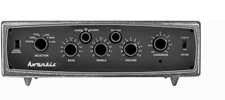 |
Avantic SPA-21 integrated stereo amplifier |
The Avantic SPA21 is styled in the American manner: the long, low look, the near-black perforated cover against the bronze plastic panel with its black and bronze knobs, all suggestive of the fashion originated over there by the Harmon-Kardon range some years ago. Closer examination reveals a loudness control, stereo and phase reverse switches and even flat pin, American-type power-outlet sockets—all essential features one gathers on that continent. However, there the resemblance ceases, so these details are probably arranged with one eye on the export market, a fact borne out by the inclusion of a 110 volt tap on the mains transformer. Contained in the single unit are a well-matched pair of power amplifiers (bearing a close circuit resemblance to our old friend the Mullard 5-10) and high-sensitivity preamplifiers with comprehensive tone control and equalizing arrangements: all are fed from a common power supply incorporating a valve rectifier, type EZ81. Each channel consists of an EF86 pentode input stage with its gain and response set by the input selector switch using feedback networks: there follows one half of an ECC83 double triode with feedback incorporating the switched 7.5 kc/s filter. At this point the tape output sockets are tapped off. The second half of the ECC83 incorporates the bass and treble controls in a feedback arrangement and the output is taken to a three-position switch marked: Stereo, 3D and Reverse. In the first position the signal path is straight through to the associated power amplifier, in the second the signal is fed to both amplifiers (and any output from the other preamplifier stages is shorted out) and in the third, the signal path is to the opposite power amplifier. Next in the circuit are the balance, volume and loudness controls and then the power amplifier consisting of EF86 first stage, ECC83 cathode coupled phase splitter and EL84 output pentodes, with feedback from secondary of output transformer to cathode of EF86. All sound, well-established design, known to be capable of an excellent result, but not usually to be found, in duplicate, in a space only 14 inches square and 4 inches deep. I have nothing but praise and respect for a designer who can accomplish this without introducing a level of hum sufficient to shake the walls (after all, the sensitivity is 3.5 milliwatts in the tape position—less than many two-unit amplifiers) or having to use so much screened wiring that the response in the treble fails off sadly. Add to this the readily observable facts that the layout is good and accessible, the workmanship is thorough, the components are of high quality, the construction is solid, and not least, the price is modest. To be sure there are things I am not partial to: the knobs are rather close and can pinch one's fingers, the loudness control, the phase reverse switch which ought not to be necessary, the "3D" marking (surely, DUAL would be better and much nearer the truth) and the rather doubtful contact area of the loudspeaker plugs, but these are small details. On test the amplifiers performed excellently. Some people say that the measurement figures of test results do not mean much to them; in this case I shall not quote them as they followed most exactly the makers' specification given above: so much so that I remarked to a colleague who helped me take them that they gave one confidence in one's own test gear! Two things not mentioned in the specification are stability and channel balance; both were excellent. To sum up then, a commendable design carried out in a thoroughly workmanlike manner and supplied with a full instruction manual containing layout photograph, circuit diagram and parts list. G.E.H. |
 Source
unknown - circa 1959
Source
unknown - circa 1959